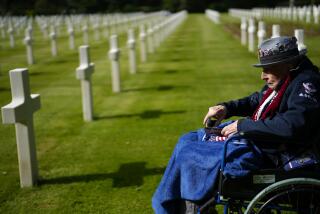World War II Vet Undertakes One Last Mission
George Ciampa is a man with a deadline.
He is determined to pass along what he learned as a skinny 18-year-old, assigned to scour European battlefields for bodies and parts of bodies and place them in makeshift mattress-cover shrouds for burial.
What he learned, he says, was the fragility of freedom, and what happens when it is taken away.
Veterans of World War II are dying at a rate of 1,000 a day, according to reports.
Ciampa fears that the hard lessons they learned may die with them.
Thatâs why, at 81, he is waging a campaign to pass the knowledge to young people.
Ciampa is arranging to take four Torrance high school teachers to Belgium next month to meet European war survivors and hear their stories. His hope is that theyâll then bring these stories to life for their students.
In finding ways to get the next generation caught up in the past, he too has gotten caught up.
On these steamy July days, he is living and breathing the war. He sleeps only four or five hours a night. He spends most of his time on the telephone, drumming up support and money. He does what he used to do. He sells. Before retiring in 1992, he worked for 26 years as a Los Angeles Times advertising manager.
âWhen he gets a good idea, heâs a good salesman. When the idea involves patriotism, heâs red hot on fire,â said a fellow Battle of the Bulge veteran, Murray Shapiro, 83, of Chatsworth.
Ciampa starts work early.
âI get e-mails from him at 6:45 in the morning. Iâm turning the alarm off at that time,â said Lori Spradlin, 31, of Torrance, who teaches world history at Torrance High School. She will leave Aug. 8 for Belgium with three other teachers, Ciampa, two other veterans and a film crew that Ciampa has hired to create a documentary. Ciampa has been planning the trip from a second-floor office in his home in the Torrance hills, the walls around him covered with framed medals and yellowing photographs. One photo taken in Europe shows him as a thin young man in uniform with wavy hair, earnest eyes and a slight smile.
He grew up in Inglewood and was just 18, the age of many Torrance High seniors, when he first reported to Ft. MacArthur in San Pedro in November 1943. He was assigned to the 607th Graves Registration Co., which sounded like a white-collar assignment when he first heard the name.
As part of his training, he was sent to witness an autopsy.
He would be responsible, he was told, for collecting the bodies of soldiers of both U.S. and enemy forces, removing personal belongings and preparing them for burial.
Ciampa landed at Normandy on D-day, June 6, 1944 -- 10 days before his 19th birthday. German shells shrieked around him. He gathered his first bodies. They were paratroopers. His team wrapped the bodies in parachutes.
Some soldiers looked like they had died in their sleep. Others were burnt like charcoal, bloated, unidentifiable. Ciampa said he dreaded looking at the faces.
He was startled, he said, to find crosses and St. Christopher medals around the necks of some Nazi soldiers. He had never realized that a Nazi could be a Catholic, like he was.
His platoon moved farther into France as the fighting continued and arrived in Paris in late August. Parisians showered them with flowers and apples.
His company moved northeast to the French-Belgian border and helped liberate the town of Fosse. There, he met 82-year-old Roman V. De Smet, a Belgian who had settled in Los Angeles.
Just before the Germans invaded, De Smet had returned to Fosse to see his family. He was not allowed to leave the country or even send letters until Allied troops arrived.
In De Smetâs cramped apartment, where the two men shared black bread spread with lard, a piece of paper was pasted on the wall. During the German occupation, De Smet had written out, and then posted, his concept of liberty, in five languages. It began:
Liberty is one of the most precious gifts that Heaven gave to man....
He gave the paper to Ciampa, who still has it.
âI saw this elderly man, talking about liberty, and here he lost his liberty for six years,â Ciampa said. âI was shattered. Iâm thinking, this sort of thing doesnât happen to us, and it happened to him. And then it struck me. It made me appreciate the fact that liberty had never been taken away from us for six years. Thatâs a long time.â
Later that year, Ciampa took part in the Battle of the Bulge, the massive Allied effort to halt the German offensive that left 76,890 soldiers dead, wounded or missing. His companyâs job on those frozen battlefields was brutal. The remains of thousands of U.S. soldiers were recovered and taken to nearby Henri-Chapelle American Cemetery. He went on to Germany, where he served in the occupying army.
In mid-January 1946, Ciampa returned to Inglewood, where his mother had kept the Christmas tree for him.
He went to college, married, was widowed, and raised two children alone.
War wasnât something he thought of every day.
But when he returned to France for the 50th anniversary of D-day at the urging of his children and his fiancee, the memories began flooding back.
âAs you get older, you reflect on these things,â he said.
The trip also made him feel more connected to Europe and the war, so when he learned that youths were doing drugs at the Henri-Chapelle cemetery, he launched a campaign to protect it, making contact with residents where he once collected bodies.
He decided then that young people should know what happened in towns like Fosse, and why, under German rule, De Smet wrote down five times what liberty meant to him. Ciampa contacted John Schmitt, associate superintendent of the Torrance schools, with the idea of taking teachers to Belgium.
âHe is so impassioned that I said, gosh, I think itâs something we should participate in,â Schmitt said.
Money for the trip isnât coming from the schools or the district. Ciampa does his own fundraising with a tenacity that took him to every car dealership on Pacific Coast Highway. The biggest donor to date is Northrop Grumman, followed by the Cantigny First Division Foundation, part of the Robert R. McCormick Tribune Foundation, a nonprofit organization endowed largely with stock of Tribune Co., owner of the Los Angeles Times. Veterans, local businesses and residents have also contributed.
He has raised $55,000 to date and expects to reach his goal of $65,000 in the next few weeks. The money will go largely to film the documentary, which he hopes will help further spread his message.
It bothers Ciampa that some might think he has a political agenda or is trying to build support for the Iraq war.
âWhat Iâm doing is about freedom. Everyone loves freedom. I donât care what you are -- a Democrat, a Republican, whatever. For a kid, staying out until 2 in the morning is freedom.â
Joey Walker, 28, of Torrance, who teaches at North High School, says many of her students âdonât have a clueâ about what it is to live through a war. âIn some ways, I probably donât have a clue,â she said.
She hopes the trip will change that, first for her and then for her students.
âItâs one thing to read about it and see videos,â she said. âBut Iâll be hearing about it from someone Iâm going to be breaking bread with, having dinner with. Thatâs something Iâm looking forward to, to learn from someone face to face.â
More to Read
Sign up for Essential California
The most important California stories and recommendations in your inbox every morning.
You may occasionally receive promotional content from the Los Angeles Times.










